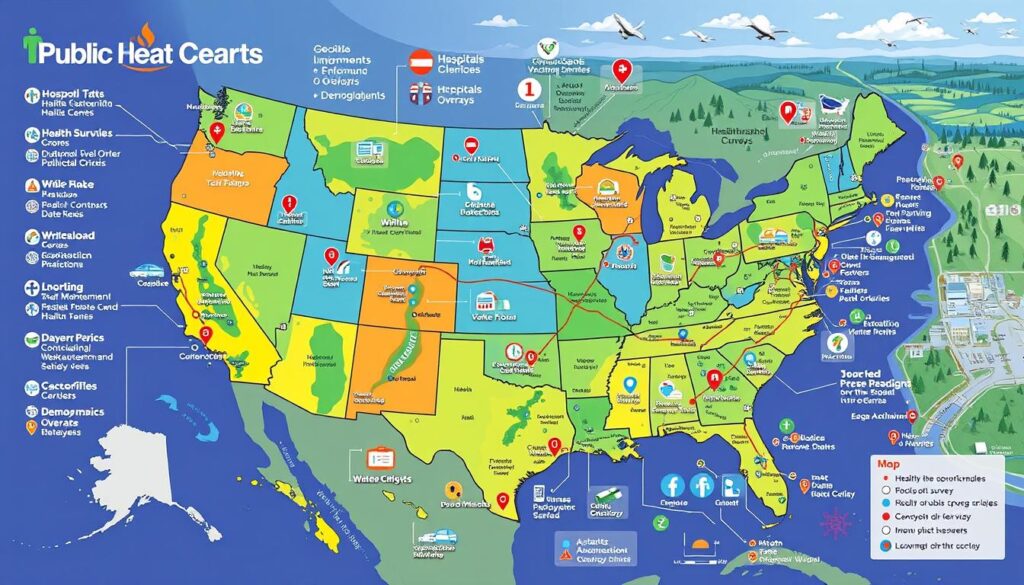Using GIS for Public Health Mapping
Geographic Information Systems (GIS) are now key in public health. They help health experts and policymakers tackle big health issues. GIS uses spatial analysis to change how we watch over diseases, make healthcare easier to get, and do research on health.
GIS mixes different data types, like people’s info and environmental factors. This helps health workers see health patterns and trends clearly. They can spot risky areas, track disease spread, and make healthcare better where it’s needed most.
GIS has made a big difference in fighting health threats. It maps disease, dangers in the environment, and where healthcare is. This helps make smart choices and focus efforts to better health for everyone.
Key Takeaways
- GIS provides a comprehensive framework for integrating and visualizing spatial data in public health
- Spatial analysis enabled by GIS allows for the identification of high-risk areas and optimization of healthcare resource allocation
- GIS-powered disease surveillance and mapping enhance our ability to monitor and respond to emerging health threats
- Integrating GIS into public health practices has led to significant advancements in evidence-based decision-making and targeted interventions
- GIS technology is revolutionizing the way we approach complex health challenges and improve population health outcomes
Introduction to GIS in Public Health
Geographic Information Systems (GIS) are key in public health today. They help us understand how location affects health and disease. GIS collects, stores, and analyzes data to show these connections.
What is GIS?
GIS is a system that uses computers to handle data. It helps us see how different places are connected. We can use it to make maps and charts that show important health information.
Importance of GIS in Public Health
- Spatial epidemiology: GIS helps find and study disease patterns. This lets health experts understand why diseases spread.
- Health data visualization: GIS makes maps and charts that share health info clearly. This helps everyone understand complex health issues.
- Evidence-based decision-making: GIS combines data to help health professionals make smart choices. This includes planning and policy-making.
GIS has changed how we tackle health problems. It makes our efforts more effective and helps create healthier communities.
“GIS technology has become an indispensable tool in public health, allowing us to better understand and address complex health issues at the community level.”
Historical Context of GIS in Health
The early 19th century saw the start of public health mapping. Pioneers like John Snow used maps to fight disease. Snow’s map of a London cholera outbreak is a key moment in public health mapping.
Over time, historical GIS applications have grown with technology. From simple methods to today’s digital tools, mapping has become more advanced. This helps health experts to track and tackle health issues better.
Evolution of GIS Technology
The rise of Geographic Information Systems (GIS) has been crucial for public health mapping. In the 1960s, Roger Tomlinson started digital mapping. This led to better ways to analyze data. As technology improved, GIS became easier to use, helping health groups use geospatial data.
Key Case Studies in Public Health Mapping
- John Snow’s cholera map (1854): This work showed the source of a London cholera outbreak. It started modern epidemiology and public health mapping.
- Mapping the spread of HIV/AIDS (1980s-1990s): GIS helped track HIV/AIDS worldwide. It guided prevention and treatment plans.
- Mapping the Ebola outbreak in West Africa (2014-2016): GIS dashboards and data visualization were key. They helped track Ebola and coordinate responses.
These examples show how GIS has helped fight disease outbreaks. They highlight the importance of GIS in public health today.
Applications of GIS in Public Health
Geographic Information Systems (GIS) are key in public health. They help tackle many challenges. GIS is great for tracking diseases and planning health resources.
Disease Surveillance and Tracking
GIS is top-notch for spotting disease patterns and tracking outbreaks. It maps disease incidence and prevalence. This helps healthcare providers quickly find and monitor disease clusters.
For instance, GIS has been crucial in tracking COVID-19. It helps public health officials see infection rates and hospitalizations. This data leads to better decisions and containment efforts.
Health Resource Allocation
GIS is also vital for fair healthcare resource distribution. It ensures communities get the care they need. GIS maps population density, socioeconomic status, and healthcare infrastructure.
This helps pinpoint underserved areas. It guides where to place hospitals and clinics. GIS helps make healthcare more accessible, especially in remote or disadvantaged areas.
| GIS Application | Description | Key Benefits |
|---|---|---|
| Disease Surveillance | Mapping the incidence and spread of diseases to identify patterns and emerging clusters | Enables targeted interventions, resource allocation, and more effective containment strategies |
| Health Resource Allocation | Optimizing the placement of healthcare facilities and services based on population needs and existing infrastructure | Improves access to care, particularly in underserved areas, and enhances the overall efficiency of the public health system |
As public health evolves, GIS will play an even bigger role. It will give healthcare pros better tools to tackle complex issues. This will help improve community well-being.
GIS Data Sources in Public Health
Public health mapping and analysis need a variety of data sources. These include demographic info, environmental factors, and health indicators. Knowing the types of data and where to find them is key for using GIS in public health.
Types of Data Used
GIS in public health uses many data types. These include:
- Demographic data: Population stats, age, and socioeconomic status
- Environmental data: Air quality, water, land use, and weather
- Health-specific data: Disease rates, healthcare locations, and mortality
- Spatial data: Maps, transportation, and satellite images
Publicly Available GIS Data Sets
There are many public GIS datasets for health mapping. Some notable ones are:
- Centers for Disease Control and Prevention (CDC) GIS Data: A wide range of health data, including disease tracking and environmental health.
- United States Census Bureau Data: Demographic and socioeconomic data for different areas.
- National Environmental Public Health Tracking Network: Data on environmental factors like air and water quality.
- OpenStreetMap: A community-driven map for infrastructure and more.
Using these health data sources and GIS datasets is vital. It helps public health experts understand disease patterns and make better decisions.

Challenges in Implementing GIS for Health
Using Geographic Information Systems (GIS) in public health can be tough. Two big hurdles are making sure the data is good and having the right skills in healthcare.
Data Quality and Reliability
Good data is key for GIS success. But, health data can be missing, mixed up, or old. Keeping data safe and easy to get to is also a big deal. To solve these problems, we need to follow strict data rules, work with data sources, and use smart ways to mix data.
Technical Expertise Requirements
GIS needs special GIS skills and knowledge. Health workers might not know GIS well, which blocks GIS implementation challenges. To get past this, we should teach GIS well, work together across fields, and keep learning to build a strong GIS team.
| Challenge | Strategies to Overcome |
|---|---|
| Data Quality and Reliability |
|
| Technical Expertise Requirements |
|
By tackling these issues, health groups can use GIS to better health, use resources wisely, and track diseases better.
GIS Tools and Software for Public Health
In public health, GIS software is key for analyzing data, tracking diseases, and planning resources. There are many GIS tools, from free to paid options. Health experts use these tools to make the most of spatial data.
Popular GIS Software Options
Popular GIS software for public health includes ArcGIS, QGIS, and GRASS GIS. ArcGIS by Esri is known for its detailed analysis tools and strong data handling. QGIS is free and popular for its wide range of plugins. GRASS GIS is great for complex spatial modeling and raster data.
Comparing Open Source vs. Proprietary Tools
Choosing GIS software depends on what you need, how much you can spend, and your team’s skills. Open-source tools like QGIS and GRASS GIS are cheaper and flexible. They let you customize the software for your needs. But, proprietary tools like ArcGIS offer more features and tools for analysis, though they cost more.
Deciding between open-source and proprietary GIS software depends on your project’s needs, budget, and team’s skills. By looking at each tool’s features, you can pick the best one for your spatial analysis and mapping needs.
Success Stories in GIS Public Health Mapping
GIS technology has changed public health around the world. It has led to amazing results through spatial analysis. These GIS success stories show how geospatial tools improve community health. They help make better, data-based decisions in public health.
Notable Projects and Outcomes
One great example is fighting malaria in sub-Saharan Africa. GIS helped find high-risk areas. This led to better use of resources and targeted public health interventions. As a result, malaria deaths went down a lot.
In the U.S., GIS helped tackle the opioid crisis. Health departments used maps to find overdose hotspots. This allowed them to send naloxone and improve emergency help in those areas.
Lessons Learned from Successful Implementations
These GIS success stories teach us a lot for future public health interventions. They show the value of working together, good data management, and easy-to-use GIS tools. These tools help everyone make better decisions.
Also, these examples highlight the need for training. Public health workers need to know how to use GIS fully.
“GIS has become an indispensable tool in our arsenal for addressing complex public health challenges. By harnessing the power of spatial data, we can develop more targeted, impactful interventions that truly improve the lives of the communities we serve.”
– Dr. Amelia Hawkins, Director of Public Health, City of Riverdale
Future Trends in GIS for Public Health
GIS (Geographic Information Systems) is growing fast, bringing new chances for public health. AI (Artificial Intelligence) and machine learning are key. They will change how we fight diseases, use resources, and manage health for everyone.
Innovations on the Horizon
AI and machine learning are big steps forward. They help find disease outbreaks and spot risky areas. AI looks at big data, like sensor info and health records, to find patterns humans miss.
Drone and satellite images are also getting better. They help us check air and water quality and track diseases. This gives us new ways to make smart health choices.
The Role of AI and Machine Learning
AI and machine learning are getting smarter. They will help a lot in public health GIS. They can predict diseases, find who’s at risk, and use resources wisely. AI makes sense of big data, helping us make better health decisions.
AI and GIS together will make disease tracking better. This means quicker action and better health for all. The future of GIS in public health looks very promising.
Conclusion
GIS has changed public health a lot. It helps track diseases better, use resources wisely, and make decisions based on data. This has greatly improved health outcomes for people.
Summary of Key Points
GIS technology has come a long way. It’s used for tracking diseases and planning health resources. Now, there are better GIS data and easier-to-use software. This has made GIS more common in healthcare.
The Future of GIS in Public Health
The future of GIS in public health looks bright. New technologies like AI and machine learning will help a lot. GIS will be key in solving health problems and making systems better.







